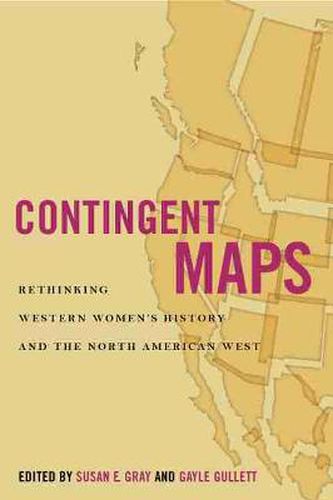Readings Newsletter
Become a Readings Member to make your shopping experience even easier.
Sign in or sign up for free!
You’re not far away from qualifying for FREE standard shipping within Australia
You’ve qualified for FREE standard shipping within Australia
The cart is loading…






Contingent Maps is an appeal to all who read, write, and care about the history of women in the North American West. Susan E. Gray and Gayle Gullett, former co-editors of Frontiers: A Journal of Women Studies, argue that the discipline of Western women’s history, despite its many years of accomplishment, remains the stepsister to both U.S. women’s history and the New Western history. The problem, they assert, is one of place. Western women’s history remains unhappily chained to one place, Frederick Jackson Turner’s mythical frontier, where white civilization vanquished Indigenous savagery. Drawing on the work of feminist geographers, Gray and Gullett contend that the West is better understood as a place of many places.
Contingent Maps demonstrates how employing place as an analytical tool transforms Western women’s history. Gray and Gullett depict place as not only a physical location but as a way of understanding, as the spatial configuration of power relations that are always in flux. As a place and many places, the West is therefore always being constructed. All maps are contingent, as Gray and Gullett’s reading of the articles in this collection attest. Contingent Maps offers histories of Wests ranging from the nineteenth century to the near present. This synthesis of feminist history and geography has the potential to revitalize the field of Western women’s history.
$9.00 standard shipping within Australia
FREE standard shipping within Australia for orders over $100.00
Express & International shipping calculated at checkout
Contingent Maps is an appeal to all who read, write, and care about the history of women in the North American West. Susan E. Gray and Gayle Gullett, former co-editors of Frontiers: A Journal of Women Studies, argue that the discipline of Western women’s history, despite its many years of accomplishment, remains the stepsister to both U.S. women’s history and the New Western history. The problem, they assert, is one of place. Western women’s history remains unhappily chained to one place, Frederick Jackson Turner’s mythical frontier, where white civilization vanquished Indigenous savagery. Drawing on the work of feminist geographers, Gray and Gullett contend that the West is better understood as a place of many places.
Contingent Maps demonstrates how employing place as an analytical tool transforms Western women’s history. Gray and Gullett depict place as not only a physical location but as a way of understanding, as the spatial configuration of power relations that are always in flux. As a place and many places, the West is therefore always being constructed. All maps are contingent, as Gray and Gullett’s reading of the articles in this collection attest. Contingent Maps offers histories of Wests ranging from the nineteenth century to the near present. This synthesis of feminist history and geography has the potential to revitalize the field of Western women’s history.